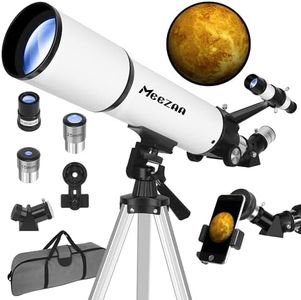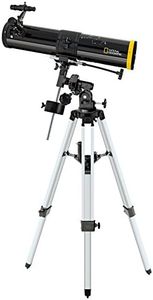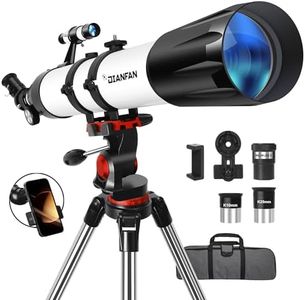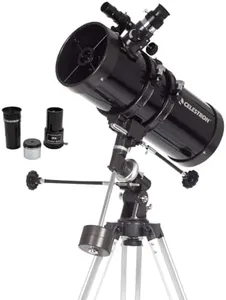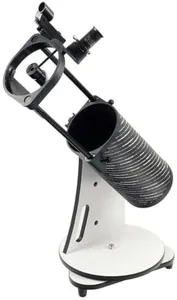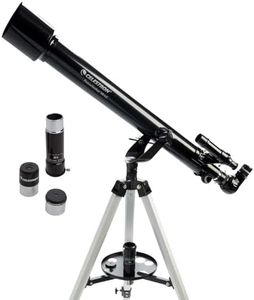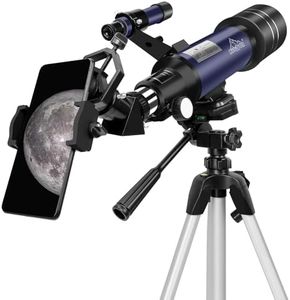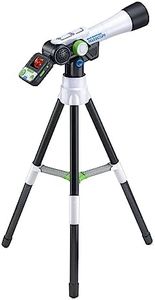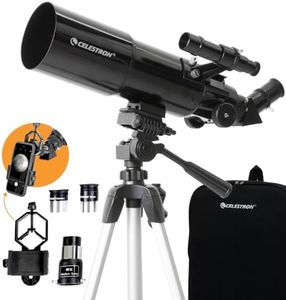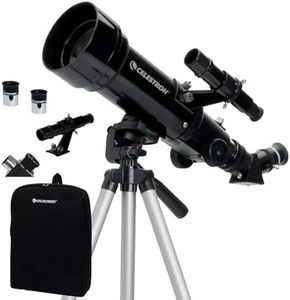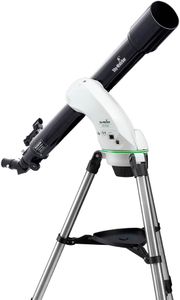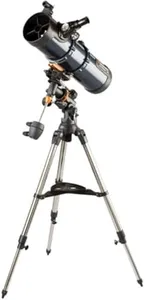We Use CookiesWe use cookies to enhance the security, performance,
functionality and for analytical and promotional activities. By continuing to browse this site you
are agreeing to our privacy policy
10 Best Telescopes For Kids
From leading brands and best sellers available on the web.By clicking on a link to a third party's website, log data is shared with that third party.
Buying Guide for the Best Telescopes For Kids
Choosing a telescope for kids can be a fantastic way to spark their interest in science and encourage curiosity about the night sky. When considering the right telescope, focus on simplicity, durability, and fun. Picking a model that is easy to use will ensure that children spend more time exploring and less time getting frustrated with complicated equipment. Size and portability are also important since kids should be able to carry and set up their telescope by themselves. By paying attention to the basic specifications, you’ll be able to find a telescope that matches a child’s age, ability, and interest level, making stargazing a memorable and educational activity.Aperture (Diameter of Main Lens or Mirror)Aperture refers to the size of the main lens or mirror that gathers light in a telescope. This is one of the most important specs because the larger the aperture, the more light the telescope can collect, making objects appear brighter and clearer. For kids, entry-level telescopes often come with apertures ranging from 50mm to 90mm, which are solid for viewing the moon, planets, and some brighter stars. Bigger apertures (100mm and above) give more detail but also make the telescope larger and possibly harder to use and carry. For beginners and young children, a moderate aperture strikes a good balance between easy use and satisfying views.
MagnificationMagnification tells you how much larger objects will appear through the telescope. It's determined by the combination of the telescope and the eyepiece being used. While it may be tempting to go for higher magnification, more is not always better — excessive magnification can blur the image if the telescope isn't designed for such power. For kids, starting with magnification in the range of 30x to 60x is usually enough to see features on the moon and planets. It's better to have a sharp, clear image at lower magnification than a blurry one at high power. Most entry-level telescopes include two or more eyepieces so kids can experiment and learn how magnification works.
Mount TypeThe mount is what supports the telescope and allows you to point it at different parts of the sky. There are two main types: altazimuth and equatorial. Altazimuth mounts move up-down and left-right, which are intuitive and easy for kids to use. Equatorial mounts follow the motion of the stars, which can be helpful for astronomy but are more complex to set up and operate. For children, an altazimuth mount is often the best choice—it keeps things simple, letting kids quickly point and look without much setup.
Telescope Type (Refractor, Reflector, Compound)Telescopes come in a few main types: refractors use lenses, reflectors use mirrors, and compound designs combine both. Refractors are good for beginners because they're generally easy to use, require little maintenance, and provide crisp views of the moon and planets. Reflectors offer more aperture for the price but can be bigger and might need occasional mirror adjustments. Compound telescopes are more advanced and are best saved for when kids have more experience. For most children, a small refractor is lightweight, sturdy, and simple to operate, making it an excellent starting point.
Portability and DurabilityA telescope's portability and sturdiness are key, especially for young users. Lightweight models are easier for kids to carry and set up themselves. Durability is important, as kids may bump or drop the telescope. Look for models made of sturdy materials, with stable tripod legs and simple assembly. A portable, tough telescope invites more frequent use and encourages kids to take it outdoors for star parties or camping trips.
Ease of Use and AccessoriesFeatures that make a telescope easy to assemble and operate will keep kids engaged. Simple setup, easy-to-understand instructions, and user-friendly finderscopes (small scopes that help aim the main telescope) are very helpful. Many kid-friendly telescopes come with starter kits that include eyepieces, finderscopes, and even star charts. The more accessible and complete the package, the more likely a child will have a rewarding experience and stick with the hobby.
